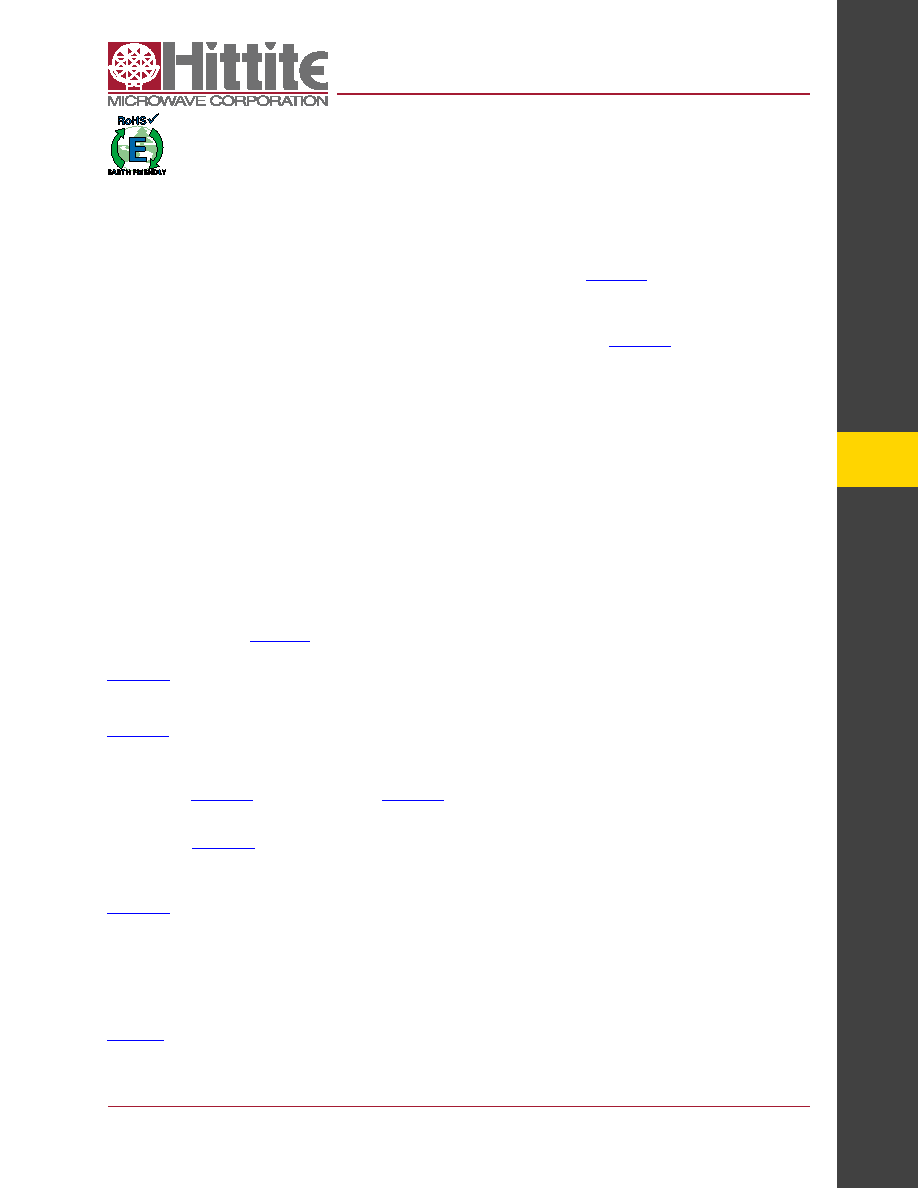- 您现在的位置:买卖IC网 > Sheet目录1996 > HMC704LP4E (Hittite Microwave Corporation)IC FRACT-N PLL 16BIT 24QFN

p
ll
s
-
s
M
T
5 - 20
HMC704LP4E
v03.1211
8 GHz fractionaL-n PLL
For price, delivery, and to place orders: Hittite Microwave Corporation,20 Alpha Road, Chelmsford, MA 01824
Phone: 978-250-3343
Fax: 978-250-3373
Order On-line at www.hittite.com
Application Support: Phone: 978-250-3343 or apps@hittite.com
rf Path ’n’ Divider
The main RF path ’N’ divider is capable of divide ratios anywhere between 219-1 (524,287) and 16 . This divider for ex-
ample could divide a 4GHz input to a PD frequency anywhere between its maximum output limit of 115MHz to as low as
7.6kHz. The ’N’ divider output may be viewed in test mode on LD_sDO by setting “Reg 0Fh”[4:0] = 10d. When operating
in fractional mode the N divider can change by up to +/-4 from the average value. Hence the selected divide ratio in
fractional mode is restricted to values between 219-5 (524,283) and 20.
If the VCO input is above 4GHz then the 8GHz fixed RF divide-by-2 should be used, “Reg 08h”[19] = 1. In this case the
total division range is restricted to even numbers over the range 2*(219-5) (1,048,566) to 40.
charge Pump and Phase Detector
The Phase Detector or PD has two inputs, one from the reference path divider and one from the RF path divider. When
in lock these two inputs are at the same average frequency and are fixed at a constant average phase offset with re-
spect to each other. We refer to the frequency of operation of the PD as fpd. Most formula related to step size, delta-sig-
ma modulation, timers etc., are functions of the operating frequency of the PD, fpd is sometimes referred to as the com-
parison frequency of the PD.
The PD compares the phase of the RF path signal with that of the reference path signal and controls the charge pump
output current as a linear function of the phase difference between the two signals. The output current varies in a linear
fashion over nearly ±2π radians (±360) of input phase difference.
Phase Detector and charge Pump functions
Phase detector register “Reg 08h” allows manual access to control special phase detector features.
“Reg 0Bh”[2:0] allows fine tuning of the PD reset path delay. This adjustment can be used to improve performance at
very high PD rates. Most often this register is set to the recommended value only.
“Reg 06h”[5] and [6] enables the PD UP and DN outputs respectively. Disabling prevents the charge pump from pump-
ing up or down respectively and effectively tri-states the charge pump while leaving all other functions operating inter-
nally.
CP Force UP “Reg 08h”[9] and CP Force DN “Reg 00h”[10] allows the charge pump to be forced up or down respec-
tively. This will force the VCO to the ends of the tuning range which can be useful for testing of the VCO.
PD Force Mid “Reg 0Bh”[11] will disable the charge pump current sources and place a voltage source on the loop filter
at approximately VPPCP/2. If a passive filter is used this will set the VCO to the mid-voltage tuning point which can be
useful for testing of the VCO.
“Reg 0Bh”[21:7] control other aspects of the phase detector operation and should be set to recommended values.
PLL Jitter
The standard deviation of the arrival time of the VCO signal, or the jitter, may be estimated with a simple approximation
if we assume that the locked VCO has a constant phase noise,
( )
2
0
f
Φ
, at offsets less than the loop 3dB bandwidth and
a 20dB per decade roll off at greater offsets. The simple locked VCO phase noise approximation is shown on the left of
发布紧急采购,3分钟左右您将得到回复。
相关PDF资料
HMC830LP6GE
IC FRACT-N PLL W/VCO 40QFN
HMP8117CNZ
IC VIDEO DECODER NTSC/PAL 80PQFP
HMP8156ACNZ
IC VIDEO ENCODER NTSC/PAL 64MQFP
HSP45102SC-40Z
IC OSC NCO 40MHZ 28-SOIC
HSP45106JC-33Z
IC OSC NCO 33MHZ 84-PLCC
HSP45116AVC-52Z
IC OSC NCO 52MHZ 160-MQFP
ICL7109EPL+
IC ADC 12BIT 3-ST 40-DIP
ICM7217AIPI
IC OSC UP/DWN CNTR 2MHZ 28-DIP
相关代理商/技术参数
HMC704LP4ETR
制造商:Hittite Microwave Corp 功能描述:IC FRACT-N PLL 16BIT 24QFN
HMC705LP4
制造商:HITTITE 制造商全称:Hittite Microwave Corporation 功能描述:6.5 GHz PROGRAMMABLE DIVIDER (N = 1 - 17)
HMC705LP4E
制造商:Hittite Microwave Corp 功能描述:IC DIVIDER HBT PROGR 24-QFN
HMC705LP4ETR
功能描述:IC DIVIDER HBT PROGR 24QFN 制造商:analog devices inc. 系列:- 包装:剪切带(CT) 零件状态:在售 功能:分频器 频率:100MHz ~ 6.5GHz RF 类型:- 辅助属性:- 封装/外壳:24-VFQFN 裸露焊盘 供应商器件封装:24-QFN(4x4) 标准包装:1
hmc706lc3c
制造商:Hittite Microwave Corp 功能描述:IC CONV NRZ-RZ 13GBPS 16SMD
HMC707LP5
制造商:HITTITE 制造商全称:Hittite Microwave Corporation 功能描述:0.5 dB LSB 6-BIT DIGITAL VARIABLE GAIN AMPLIFIER, 700 - 1200 MHz
HMC707LP5_10
制造商:HITTITE 制造商全称:Hittite Microwave Corporation 功能描述:0.5 dB LSB 6-BIT DIGITAL VARIABLE GAIN AMPLIFIER, 700 - 1200 MHz
HMC707LP5E
制造商:Hittite Microwave Corp 功能描述:IC AMP DVGA LNA 6-BIT 32-QFN